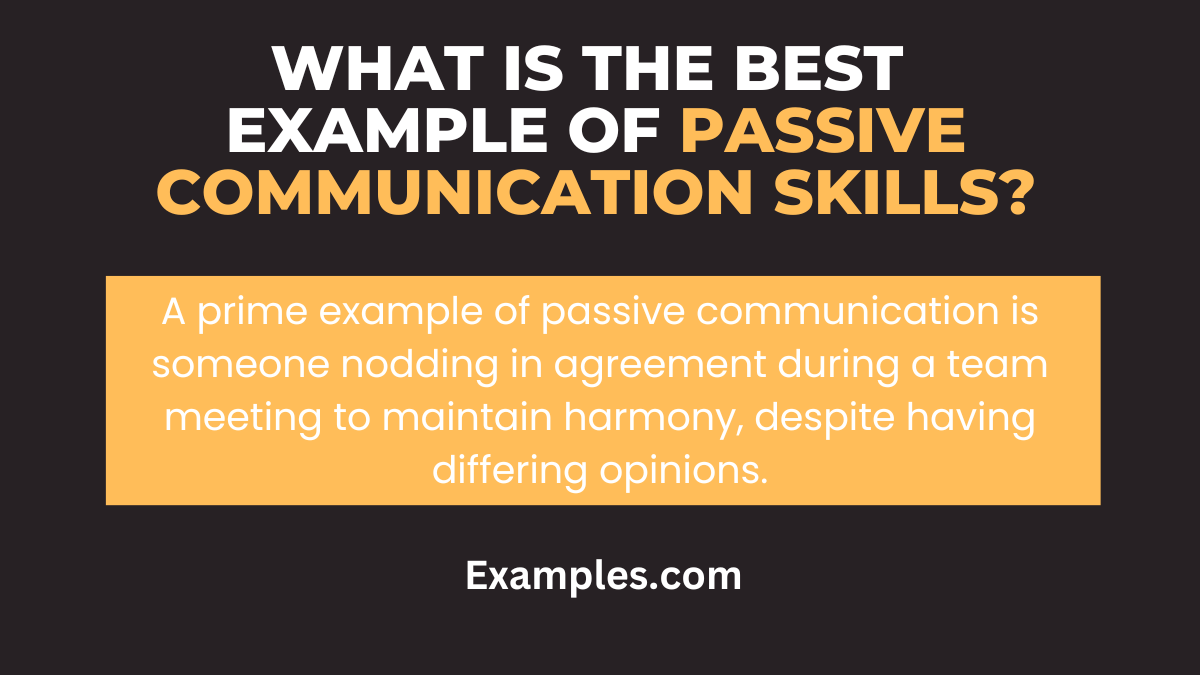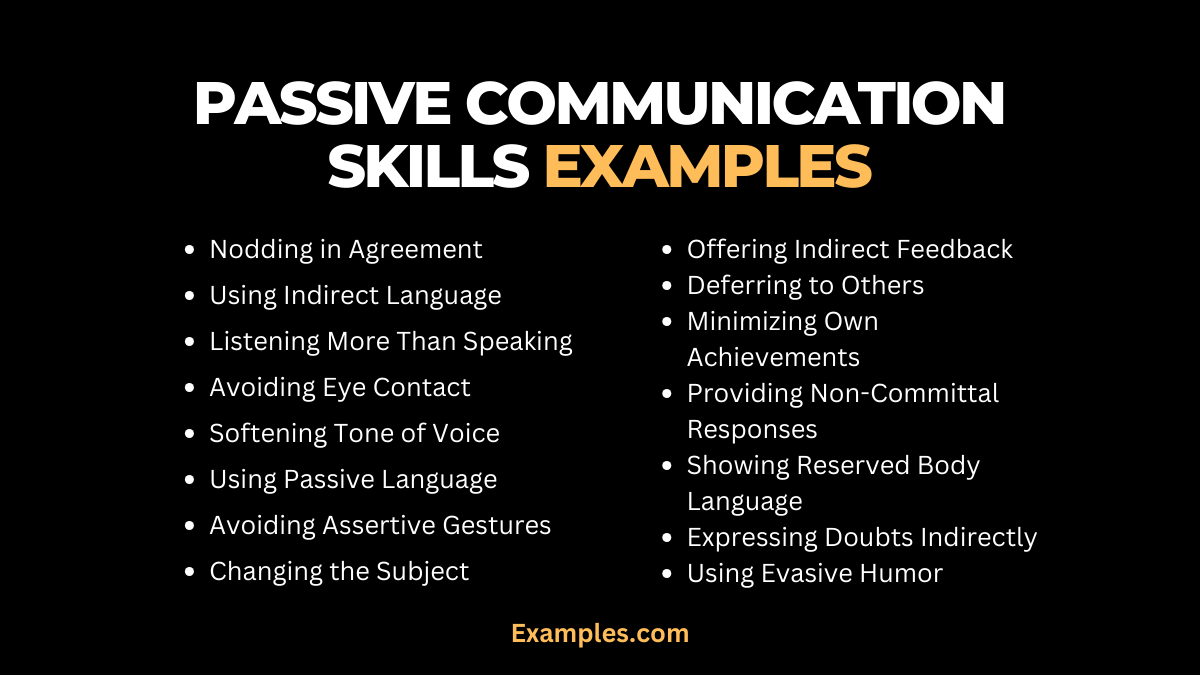14+ Passive Communication Skills Examples
Passive communication, often overshadowed by its more assertive counterparts, plays a crucial role in maintaining harmony and understanding in various settings. This comprehensive guide delves into the subtle art of Passive Communication Skills, highlighting their significance in everyday interactions. We’ll explore how these skills can be therapeutic, aiding in conflict resolution and fostering a deeper sense of empathy. Whether in personal relationships or professional environments, understanding and effectively using passive communication can be transformative. This guide provides rich, practical examples, making it an essential resource for anyone looking to enhance their communication repertoire.
What is the Best Example of Passive Communication Skills?

A prime example of passive communication is when an individual agrees to go along with others’ plans or opinions, even if they have different preferences or ideas. For instance, in a team meeting, a passive communicator might nod in agreement to a proposed strategy, despite having reservations, to avoid conflict or discomfort. This approach prioritizes group harmony and reduces immediate tension, but it might lead to unexpressed concerns or ideas not being shared, potentially impacting the team’s long-term effectiveness.
15 Passive Communication Skills Examples

- Nodding in Agreement: Expressing agreement through nonverbal cues like nodding, even if not entirely convinced.
Example: “I see your point,” you nod, showing acceptance without verbal commitment. - Using Indirect Language: Communicating a preference or opinion indirectly to avoid direct confrontation.
Example: “It might be a good idea to consider other options,” instead of outright rejection. - Listening More Than Speaking: Prioritizing listening over contributing in conversations to avoid imposing views.
Example: “I’m interested to hear more about your perspective,” encouraging others to share. - Avoiding Eye Contact: Using limited eye contact to reduce the intensity of a conversation.
Example: Glancing away occasionally to signal discomfort or unwillingness to engage deeply.

- Softening Tone of Voice: Speaking in a gentle, non-confrontational tone to convey a sense of agreeableness.
Example: “I understand what you’re saying,” spoken softly to reduce potential conflict. - Using Passive Language: Phrasing statements in a passive voice to lessen the impact.
Example: “It was considered that…” instead of directly stating who did the considering. - Avoiding Assertive Gestures: Refraining from strong or assertive body language.
Example: Keeping hands still instead of gesturing emphatically during a disagreement. - Changing the Subject: Steering conversations away from contentious topics.
Example: “That’s an interesting point, but have you seen the latest project updates?” - Offering Indirect Feedback: Providing feedback in a roundabout way.
Example: “Some people might find that approach a bit challenging,” instead of direct criticism. - Deferring to Others: Letting others take the lead or make decisions.
Example: “I’m okay with whatever the team decides,” showing willingness to follow. - Minimizing Own Achievements: Downplaying personal accomplishments to avoid seeming boastful.
Example: “It was just a small contribution on my part,” despite significant effort.

- Providing Non-Committal Responses: Giving vague or non-committal answers to avoid conflict.
Example: “Perhaps that could work,” instead of a clear yes or no. - Showing Reserved Body Language: Maintaining a closed or reserved posture.
Example: Crossing arms or maintaining a small physical footprint in group settings. - Expressing Doubts Indirectly: Raising concerns in a non-direct way.
Example: “Do you think there might be another way to approach this?” - Using Evasive Humor: Employing humor to deflect or evade direct answers.
Example: “Well, as they say, there are many ways to skin a cat!” to avoid a direct response.
Passive Communication Skills Examples for Resume
- Active Listening Abilities: Demonstrating the capacity to listen and understand others’ perspectives without dominating conversations.
Example: “Skilled in active listening, consistently acknowledged for understanding and addressing team concerns effectively.” - Conflict Avoidance: Expertise in preventing conflicts through diplomatic communication.
Example: “Adept at conflict avoidance, ensuring smooth team dynamics through proactive and harmonious communication.” - Empathy in Interactions: Exhibiting a strong sense of empathy in communications.
Example: “Highly empathetic communicator, excelling in creating a supportive and inclusive team environment.” - Non-Confrontational Feedback: Giving feedback in a gentle, constructive manner.
Example: “Experienced in providing non-confrontational feedback, fostering a positive and growth-oriented team culture.” - Mediating Skills: Acting as a mediator to resolve misunderstandings or tensions.
Example: “Proficient in mediation, successfully resolving interpersonal conflicts within teams.”
How can Passive Communication Skills be Improved?
- Practice Active Listening: Enhance your Nonverbal Communication by becoming an active listener. Focus on understanding the speaker’s message before responding, which can be therapeutic for both parties.
- Increase Self-Awareness: Reflect on your Communication Style. Understanding your natural tendencies in communication can help identify areas for improvement and develop more Effective Communication techniques.
- Seek Feedback: Encourage others to provide feedback on your Interpersonal Communication. This insight can be invaluable in understanding how your passive communication is perceived and can guide you toward more Assertive Communication when necessary.
- Engage in Role-Playing: Practice different communication scenarios to enhance your Oral Communication skills. Role-playing can provide a safe environment to experiment with more assertive language while maintaining a passive approach.
- Learn from Others: Observe individuals who exemplify effective Passive Communication. Mentoring or coaching can provide practical insights into refining your communication approach, blending empathy with clarity.
What are the Drawbacks of Passive Communication Skills?
- Risk of Misunderstanding: Over-reliance on passive communication can lead to Miscommunication. Without clear expression, others may misunderstand or overlook your needs and opinions.
- Potential for Resentment: Consistently prioritizing others’ needs can lead to internal resentment. This is particularly problematic in environments that require open and Direct Communication.
- Lack of Assertiveness: Passive communicators often struggle in situations that require Assertive Communication. This can hinder personal and professional growth, particularly in leadership roles.
- Communication Barriers may form as a result of not expressing thoughts or feelings clearly, leading to a buildup of unaddressed issues and reducing Effective Communication.
- Reduced Influence: In scenarios like Crisis Communication or Leadership Communication, a passive style may diminish your influence and effectiveness, as decisive and clear communication is often required.
Understanding passive communication skills is crucial for effective interaction. By recognizing examples like avoiding confrontation and minimizing one’s achievements, individuals can identify areas for improvement. This guide offers insights and tips to navigate and refine these skills, enhancing personal and professional relationships through more assertive and balanced communication strategies.



